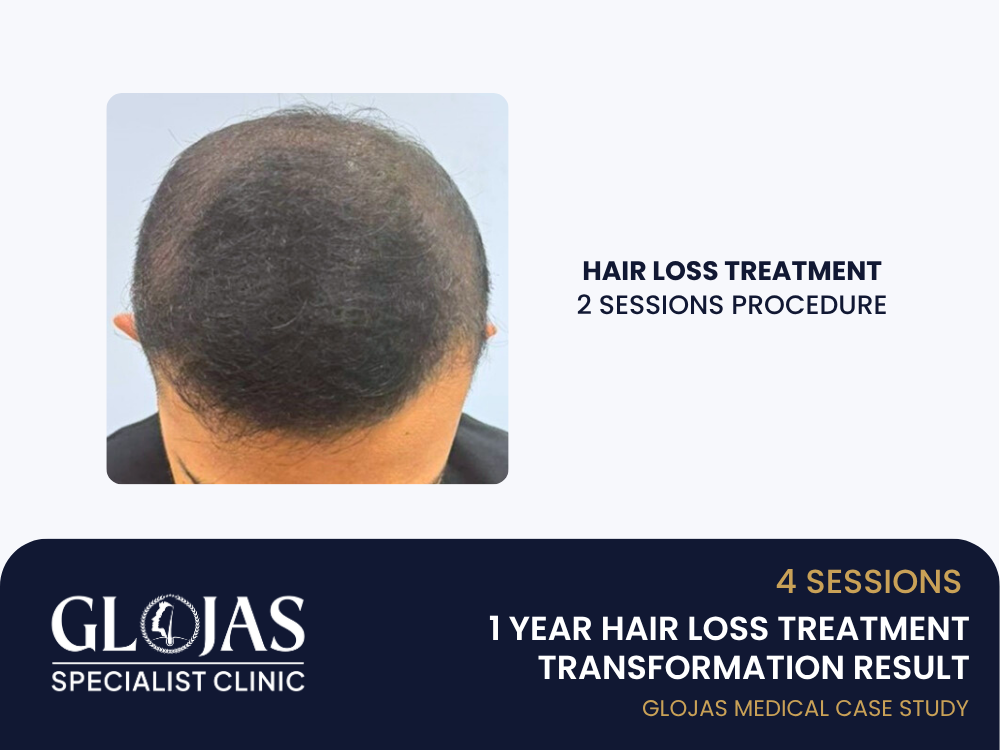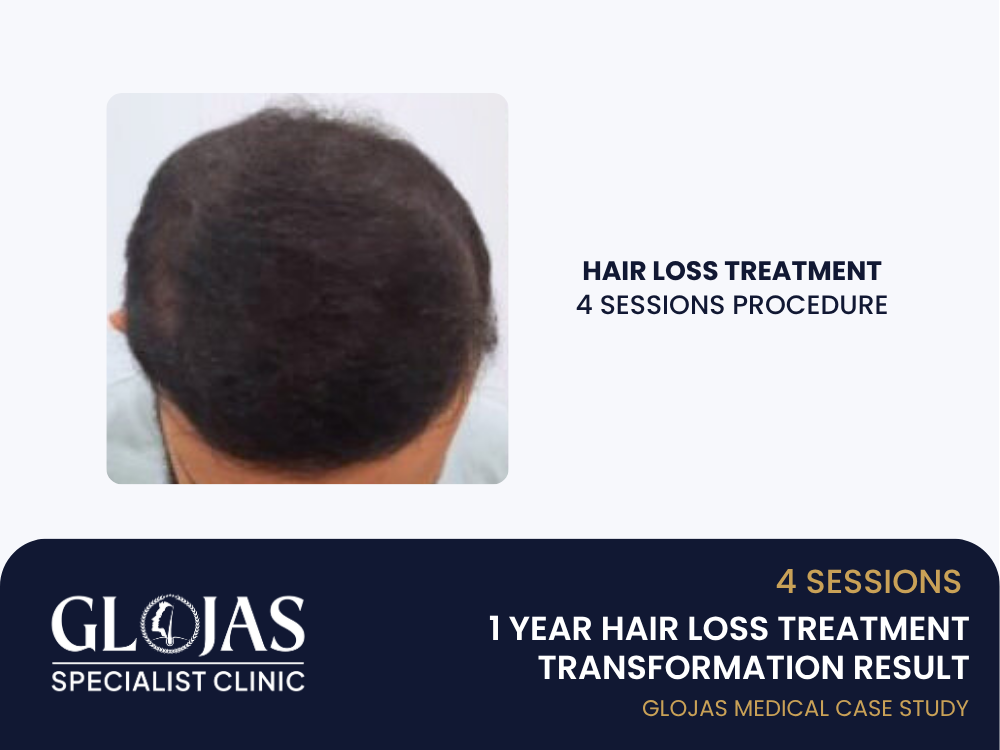Hair thinning is one of the most common concerns among men aged 25 and above. Whether caused by genetics, hormones, or lifestyle, early intervention can often reverse or significantly slow the progression of hair loss. In this case study, we follow a 34-year-old male patient who underwent a non-surgical hair loss treatment program consisting of 4 targeted sessions over one year.
The goal was to improve overall hair density, reduce shedding, and restore confidence, without undergoing hair transplant surgery.
Patient Background
Age: 34
Gender: Male
Concern: Progressive hair thinning, especially at the crown and temples
Diagnosis: Male pattern hair loss – Norwood Stage II-III
Medical History: No underlying conditions, non-smoker
Previous Solutions Tried: Minoxidil (topical), DHT-blocking shampoo
Hair Type: Straight, medium-fine density, dark brown
Consultation & Assessment
During the consultation, a trichoscopy analysis was performed to assess scalp health, follicle density, and active miniaturization zones. The scalp showed reduced density in the frontal region and crown, with early signs of follicular shrinkage due to DHT sensitivity.
Treatment options discussed:
Platelet-Rich Plasma (PRP)
Growth Factor Therapy
Laser Light Therapy
Oral finasteride (optional, declined by patient)
The patient opted for a 4-session PRP-based therapy, spaced 6–8 weeks apart, supported with topical and nutritional boosters.
Hair Loss Treatment Protocol: 4 Sessions

Technique: PRP (Platelet-Rich Plasma) Therapy
Sessions: 4
Interval: Every 6–8 weeks
Duration per Session: ~60 minutes
Additional Care: Scalp microneedling, biotin supplement, hair serum (topical)
Step-by-Step Breakdown:
Blood Draw – 10–15 ml of the patient’s blood extracted
Centrifugation – Platelets isolated and concentrated
Microneedling – Stimulates the scalp for better absorption
PRP Injection – Delivered directly into thinning areas (crown, hairline)
Post-Treatment Care – No washing for 24 hours, avoid sun & sweat exposure
Progress Timeline

| Time Frame | Visible Progress |
|---|---|
| Week 1–2 | Mild soreness, slight redness on the scalp |
| Month 2 | Decrease in hair shedding, scalp feels healthier |
| Month 4 | New baby hair starts sprouting, especially at the crown |
| Month 6 | Noticeable thickening in temple areas and improved hair texture |
| Month 9 | Increased density across front and crown, the patient resumes normal styling |
| Month 12 | Full visible result – thicker, healthier hairline and crown |
Before & After Comparison

| Before | After (1 Year) |
|---|---|
| Visible thinning on the crown & temples | Crown and temples filled in with new, thicker hair |
| Difficulty styling hair | Improved texture, volume, and flexibility in hairstyles |
| Loss of confidence | Improved self-image and comfort in social & professional life |
Patient Feedback
“I was close to giving up and almost went for a transplant. But after just 4 sessions, I started seeing baby hairs again! By the 9th month, even my barber noticed the difference. The results are natural, and I feel younger.”
Maintenance & Aftercare
Continue topical minoxidil daily
Biotin and zinc supplementation
Monthly scalp massage (optional)
Annual PRP top-up (recommended for long-term results)
5 Frequently Asked Questions (FAQ)
1. Is 4 sessions enough for hair regrowth?
For early-stage hair thinning, 4 well-spaced PRP sessions are often sufficient to trigger regrowth and improve scalp health. Maintenance sessions may be advised annually.
2. Does PRP therapy hurt?
Most patients report only mild discomfort. A numbing cream is applied before injections, and any soreness usually subsides within 24–48 hours.
3. How soon can I see results?
Initial results, reduced shedding and minor regrowth, appear within 2–3 months. Full results usually develop by 9–12 months.
4. Will I need a hair transplant?
If treated early, many patients delay or avoid the need for a transplant. However, if hair loss continues, PRP can also complement future transplant procedures.
5. Is PRP therapy safe?
Yes, PRP uses your blood components, so the risk of allergic reaction is nearly zero. It’s safe when performed by trained medical professionals.
Conclusion
This case demonstrates that non-surgical hair loss treatments, such as PRP, can deliver visible, lasting results—even with just four sessions. For men facing thinning hair, especially in the early stages, PRP offers a minimally invasive, cost-effective, and natural solution.
Whether used as a standalone treatment or part of a comprehensive hair restoration plan, PRP remains a trusted option for patients seeking thicker, healthier hair without the need for surgery.
